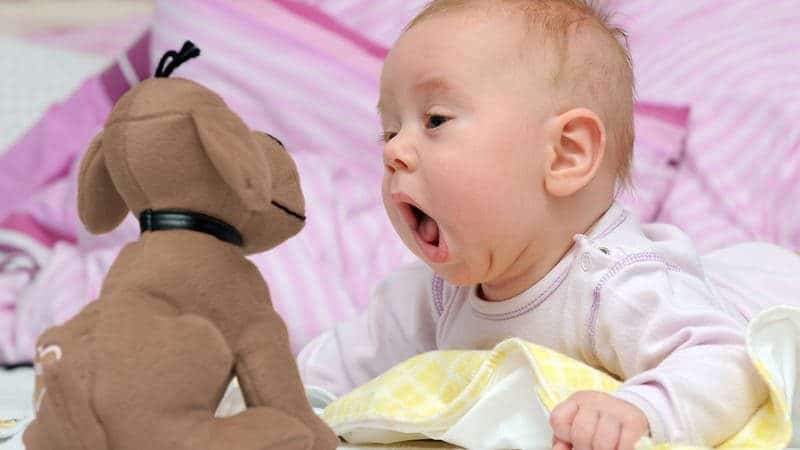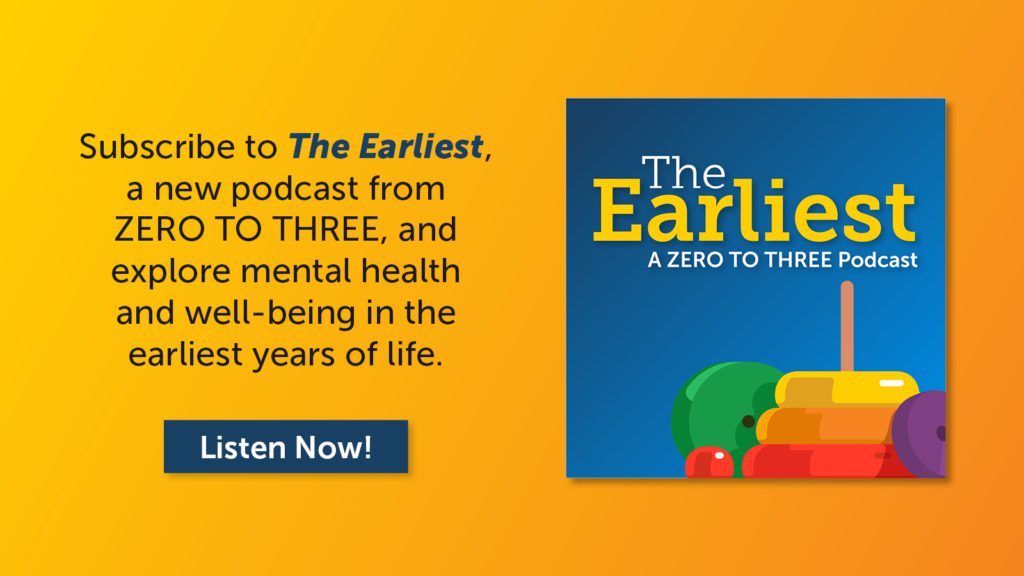Tips on Learning to Talk

This article gives a brief introduction to language development and includes age-appropriate activities for children birth to 3 years old who are learning to talk.
Learning to Talk: From Birth to 3 Months
A baby listens to your voice. He coos and gurgles and tries to make the same sounds you make. You can help a baby learn how nice voices can be when you:
- Sing to the baby. You can do this even before he is born! The baby will hear you.
- Talk to the baby. Talk to others when she is near. She won’t understand the words, but will like your voice and your smile. She will enjoy hearing and seeing other people, too.
- Plan for quiet time. Babies need time to babble and play quietly without TV or radio or other noises.
From 3 to 6 Months
A baby is learning how people talk to each other. You help him become a “talker” when you:
- Hold a baby close so he will look in your eyes.
- Talk to him and smile.
- When a baby babbles, imitate the sounds.
- If he tries to make the same sound you do, say the word again.
From 6 to 9 Months
A baby will play with sounds. Some of these sound like words, such as “baba or “dada.” Baby smiles on hearing a happy voice, and cries or looks unhappy on hearing an angry voice. You can help the baby understand words (even if she can’t say them yet) when you:
- Play games like Peek-a-Boo or Pat-a-Cake. Help her move her hands along with the rhyme.
- Give her a toy and say something about it, like “Feel how fuzzy Teddy Bear is.”
- Let her see herself in a mirror and ask, “Who’s that?” If she doesn’t respond, say her name.
- Ask the baby questions, like “Where’s doggie?” If she doesn’t answer, show her where.
From 9 to 12 Months
A baby will begin to understand simple words. She stops to look at you if you say “no-no.” If someone asks “Where’s Mommy?” she will look for you. She will point, make sounds, and use her body to “tell” you what she wants. For example she may look up at you and lift her arms up to show you she “wants up.” She may hand you a toy to let you know she wants to play. You can help the baby “talk” when you: Show her how to wave “bye-bye.”
From 12 to 15 Months
Babies begin to use words. This includes using the same sounds consistently to identify an object, such as “baba” for bottle or “juju” for juice. Many babies have one or two words and understand 25 or more. He will give you a toy if you ask for it. Even without words, he can ask you for something—by pointing, reaching for it, or looking at it and babbling. You can help a child say the words he knows when you:
- Talk about the things you use, like “cup,” “juice,” “doll.” Give a child time to name them.
- Ask a child questions about the pictures in books. Give the child time to name things in the picture.
- Smile or clap your hands when the child names the things that he sees. Say something about it. “You see the doggie. He’s sooo big! Look at his tail wag.”
- Talk about what the child wants most to talk about. Give him time to tell you all about it.
- Ask about things you do each day—“Which shirt will you pick today?” “Do you want milk or juice?”
- Build on what a child says. If he says “ball,” you can say, “That’s your big, red ball.”
- Introduce pretend play with a child’s favorite doll or toy animal. Include it in your conversations and your play. “Rover wants to play too. Can he roll the ball with us?”
From 15 to 18 Months
A child will use more complex gestures to communicate with you and will continue to build her vocabulary. She may take your hand, walk you to the bookshelf, point to a book and say “buk” to say, “I want to read a book with you.” You can help your child talk with you when you:
- Tell her “Show me your nose.” Then point to your nose. She will soon point to her nose. Do this with toes, fingers, ears, eyes, knees and so on.
- Hide a toy while she is watching. Help her find it and share in her delight.
- When he points at or gives you something, talk about the object with her. “You gave me the book. Thank you! Look at the picture of the baby rolling the ball.”
From 18 Months to 2 Years
Your baby will be able to follow directions and begin to put words together, such as “car go” or “want juice.” He will also begin to do pretend play which fosters language development. You can spur a child’s communication skills when you:
- Ask the child to help you. For example, ask him to put his cup on the table or to bring you his shoe.
- Teach a child simple songs and nursery rhymes. Read to the child. Ask him to point to and tell you what he sees.
- Encourage the child to talk to friends and family. He can tell them about a new toy.
- Engage the child in pretend play. You can talk on a play phone, feed the dolls, or have a party with the toy animals.
From 2 to 3 Years
A child’s language skills will grow by leaps and bounds. He will string more words together to create simple sentences, such as “Mommy go bye-bye.” He will be able to answer simple questions, such as “Where is your bear?” By 36 months he will be able to answer more complicated questions such as, “What do you do when you are hungry?” He will do more and more pretend play, acting out imaginary scenes such as going to work, fixing the toy car, taking care of his “family” (of dolls, animals).
You can help the child put all his new words together and teach him things that are important to know when you:
- Teach the child to say his or first and last name.
- Ask about the number, size, and shape of the things a child shows you.
- Ask open-ended questions that don’t have a “yes” or “no” answer. This helps them develop their own ideas and learn to express them. If it’s worms, you could say: “What fat, wiggly worms! How many are there?…Where are they going? Wait, watch and listen to the answer. You can suggest an answer if needed: “I see five. Are they going to the park or the store?”
- Ask the child to tell you the story that goes with a favorite book. “What happened to those three pigs?” Reading spurs language development. Take him to storytime at your local library. Your toddler will enjoy sharing books with you as well as peers.
- Do lots of pretend play. Acting out stories and role-playing create rich opportunities for using, and learning, language.
- Don’t forget what worked earlier. For example, a child still needs quiet time. This is not just for naps. Turn off the TV and radio and let the child enjoy quiet play, singing, and talking with you.
(Note: This information was adapted, with permission, from Learning Link: Helping Your Baby Learn to Talk, by C.E. Morrisset Huebner and P. Lines, 1994, Washington, DC: U.S. Department of Education, Office of Educational Research and Improvement.)

